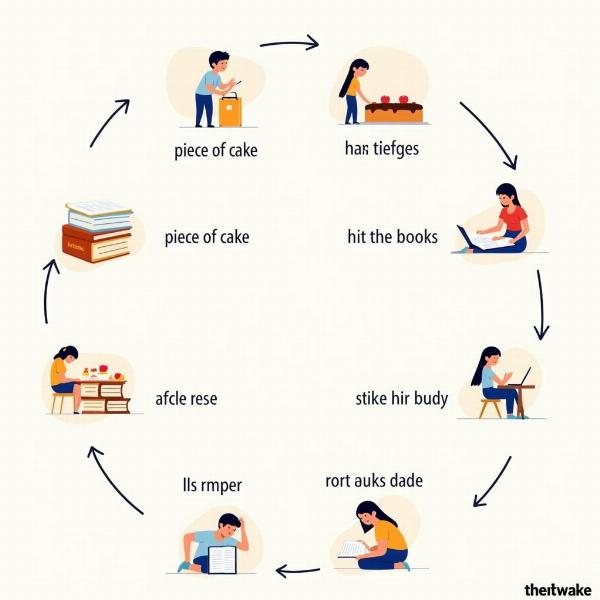Understanding common English phrases and their Hindi equivalents is essential for effective communication, especially in a diverse country like India. Whether you’re learning English, brushing up on your Hindi, or simply curious about the interplay between these two languages, this guide offers valuable insights into “english phrases with hindi meaning.” We’ll explore a range of phrases, from everyday expressions to more nuanced idioms, providing clear explanations and practical examples.
Everyday English Phrases and Their Hindi Meanings
Let’s start with some basic English phrases that are frequently used in daily conversations:
- Good morning (शुभ प्रभात – Shubh Prabhat): A polite greeting used in the morning.
- Good afternoon (नमस्कार – Namaskar): A respectful greeting used from noon until evening.
- Good evening (नमस्कार – Namaskar): Used as a greeting in the evening.
- Good night (शुभ रात्रि – Shubh Ratri): A farewell used before going to bed.
- Please (कृपया – Kripya): Used to make a request polite.
- Thank you (धन्यवाद – Dhanyavad): An expression of gratitude.
- You’re welcome (स्वागत है – Swagat hai/ कोई बात नहीं – Koi baat nahi): A polite response to “thank you.”
- Excuse me (क्षमा करें – Kshama karen): Used to politely get someone’s attention or apologize for a minor inconvenience.
- How are you? (आप कैसे हैं? – Aap kaise hain?): A common greeting inquiring about someone’s well-being.
- I’m fine, thank you (मैं ठीक हूँ, धन्यवाद – Main theek hun, dhanyavad): A typical response to “how are you?”.
Common Idioms and their Hindi Meanings
Idioms add color and depth to language, but they can be tricky to understand. Here are some common English idioms with their Hindi meanings:
- Piece of cake (बड़ा आसान – Bada aasan): Something that is very easy to do.
- Break a leg (शुभकामनाएं – Shubhkamnaen /आप सफल हों – Aap safal hon): An expression of good luck, often used in the context of performances.
- Once in a blue moon (कभी-कभार – Kabhi-kabar): Something that happens very rarely.
- Hit the books (पढ़ाई करना – Padhai karna): To study diligently.
- Let the cat out of the bag (भेद खोलना – Bhed kholna): To reveal a secret.
 Common English Idioms and their Hindi Translations
Common English Idioms and their Hindi Translations
Why Learning English Phrases with Hindi Meaning is Important
Learning English phrases with Hindi meaning bridges the communication gap between English and Hindi speakers. It empowers individuals to express themselves more accurately and understand nuances in both languages. This is especially valuable in India’s multilingual environment. Imagine trying to explain “once in a blue moon” to someone who only speaks Hindi! Knowing the equivalent “kabhi-kabar” makes the conversation much smoother.
How to Improve your Understanding of English Phrases
- Immerse yourself in the language: Watch English movies and TV shows with Hindi subtitles, listen to English music, and read English books and articles.
- Practice regularly: Use the phrases in your daily conversations, write them down, and create flashcards. Don’t be afraid to make mistakes – that’s how you learn!
- Use online resources: Meaning-Hindi.in offers comprehensive resources for learning English and Hindi, including dictionaries, phrasebooks, and translation services. idioms and phrases in english with hindi meaning and 15000 useful english phrases pdf with hindi meaning can further enhance your learning journey.
Tips for Using English Phrases Correctly
- Context is key: Pay attention to the context in which a phrase is used to avoid misunderstandings.
- Start with the basics: Master common phrases before moving on to more complex idioms.
- Be mindful of your audience: Adjust your language depending on who you are speaking to.
Conclusion
Mastering English phrases with Hindi meaning is a valuable asset in today’s interconnected world. By understanding and using these phrases correctly, you can enhance your communication skills and build stronger relationships. Whether you’re aiming for fluency or simply seeking to expand your vocabulary, consistent practice and immersion in the language are key to success. So, start learning and enjoy the journey of linguistic exploration!
FAQ
- What are some other resources for learning English phrases? Besides Meaning-Hindi.in, you can explore online dictionaries, language learning apps, and English language courses.
- How can I improve my pronunciation of English phrases? Listening to native speakers and practicing regularly are crucial for improving pronunciation.
- Is it important to learn idioms? Yes, idioms add depth and fluency to your English speaking and comprehension skills.
- How do I know if I’m using a phrase correctly? Pay attention to context and consult reliable resources like Meaning-Hindi.in for clarification.
- What is the best way to remember new phrases? Regular practice, using flashcards, and incorporating them into your daily conversations can help you remember new phrases effectively.
- Where can I find more English phrases with Hindi meanings? until when meaning in hindi and accha meaning in hindi are excellent resources on Meaning-Hindi.in.
- Can Meaning-Hindi.in help me with translation services? Yes, Meaning-Hindi.in offers professional translation services between English and Hindi, among other languages. pronote meaning in hindi demonstrates our expertise.
Meaning-Hindi.in is your trusted partner for all your Hindi translation needs. We specialize in various translation services, including business and commercial documents, legal and certified translations, technical manuals, website localization, educational and academic materials, and express translation services. Our expertise covers a wide range of specialized fields, ensuring accurate and culturally sensitive translations. Contact us today for all your translation requirements at [email protected] or call us at +91 11-4502-7584. Meaning-Hindi.in is dedicated to bridging the language gap and facilitating seamless communication.